
Market Report:
Trends in
“Make or Buy” Decisions
On this page: Summary ••• 1. Make or Buy? ••• 2. Survey Results ••• 3. More Results ••• 4. Project Business Today ••• 5. Comparisons ••• 6. Conclusions ••• 7. Are Practitioners Prepared? ••• 8. Comments ••• Appendix: The Method

Summary
Summary: A survey confirms findings from earlier research that project business management is a big trend. Work that organizations would have done internally some few years ago is now outsourced to contractors. For the contractor organizations, projects for paying customers are a growth-oriented business model.
Reference: Project Business Foundation (2021) Market Report: Trends in Make or Buy Decisions, September [Online]. Available from: https://project-business.org/research/survey-market-trends (Accessed: ## #### 202#).

1. Make or Buy?
A critical decision in a project
When managers decide whether to do project work internally or lay it partially or in full into external hands, they change the course of the project in a significant way:
The Make Option:
The project becomes a cross-functional, internal project performed by the same organization that will use the results. A set of internal agreements will govern the project. Final resolution of conflicts may require the involvement of management.
Money spent for the project will mostly remain inside the organization, where it can further circulate. The project is a cost center.
The Buy Option:
The project will turn into cross-corporate project business, performed by one or more – often many more – contractors for the paying customer. One or more contracts will govern the project. Final remedy of contractual disputes may necessitate litigation.
Money spent by the customer will leave the organization. For the contractors, this money is income, and the project is a temporary profit center.
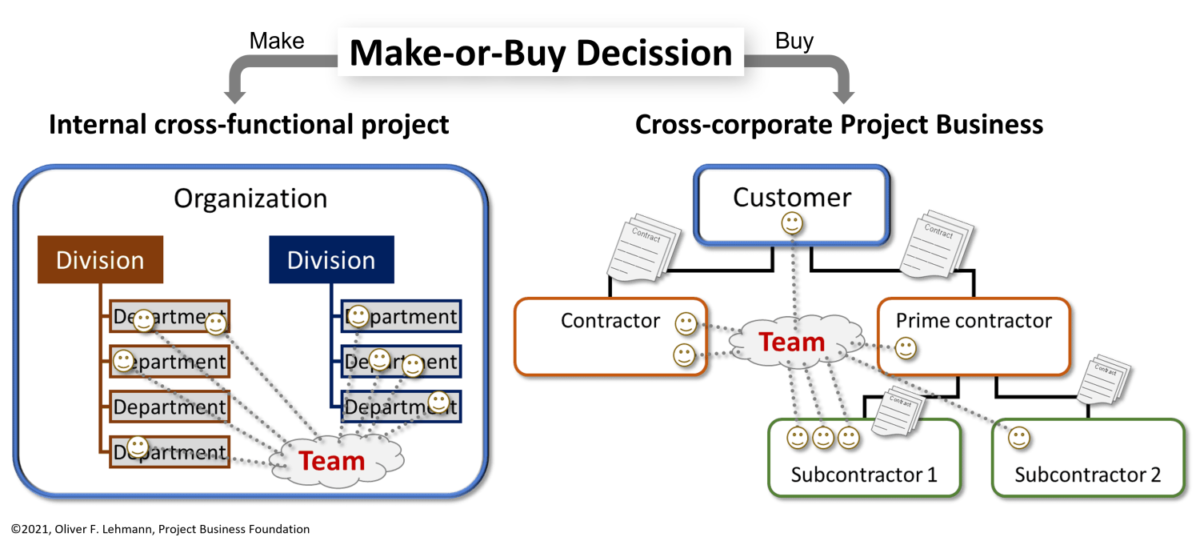

2. A Survey: What is the Trend?
We gathered data during a survey. We started it on 22-08-2021 and closed it on 30-08-2021.
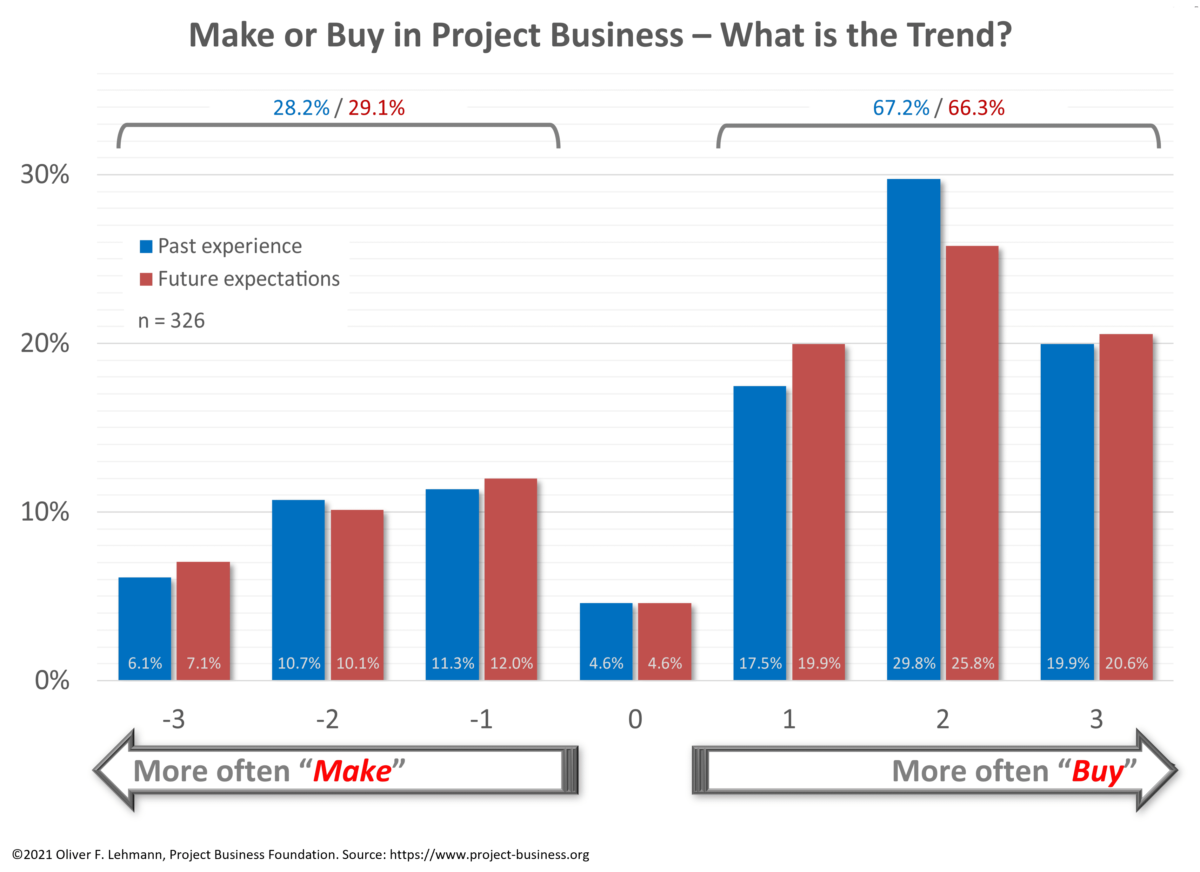

A clear trend experienced in the past: More often, Buy than Make
Two out of three respondents reported a shift towards more buying. Their organizations procured project work more often than before.

And also expected for the future: More often, Buy than Make
Two out of three respondents reported that they expect a future shift towards buying, expecting the trend to hold on.
Click here to see details on the method used.

3. More Results from the Survey
Is the trend different for world regions?
We looked at 7 world regions and compared the average numbers (from past experience and future expectations):
- Africa – 23 responses
- Asia – 68 responses
- Australia, New Zealand – 4 responses
- Europe – 79 responses
- Latin America – 18 responses
- Middle East – 17 responses
- North America (USA & Canada) – 109 responses
The results show that the tendency towards Buy is true for all regions.
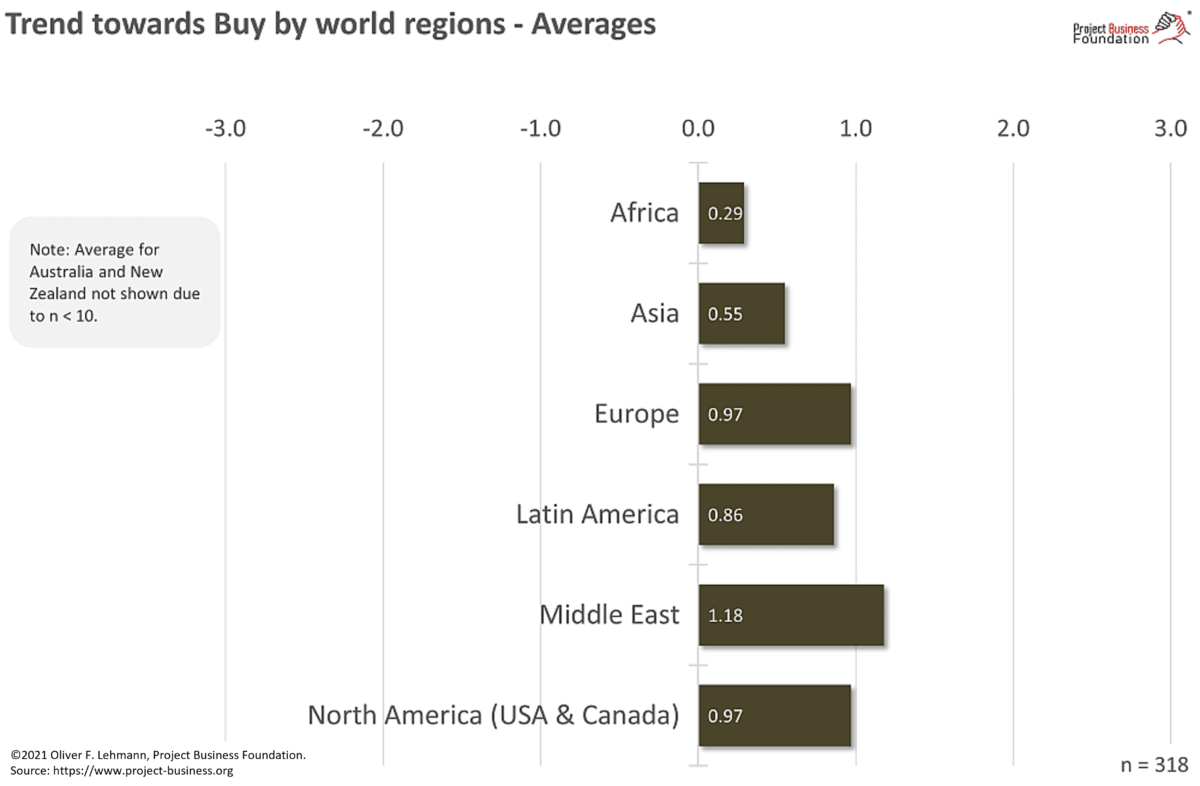
Is the trend dependent on project size?
We asked respondents for project sizes and compared the average numbers (from past experience and future expextations):
- 1-10 – 99 responses
- 11-100 – 175 responses
- 101-1,000 – 29 responses
- 1,001-10,000 – 9 responses
- more than 10,000 – 2 responses
- I do not know – 1 response
For all project sizes, the trend is towards Buy.
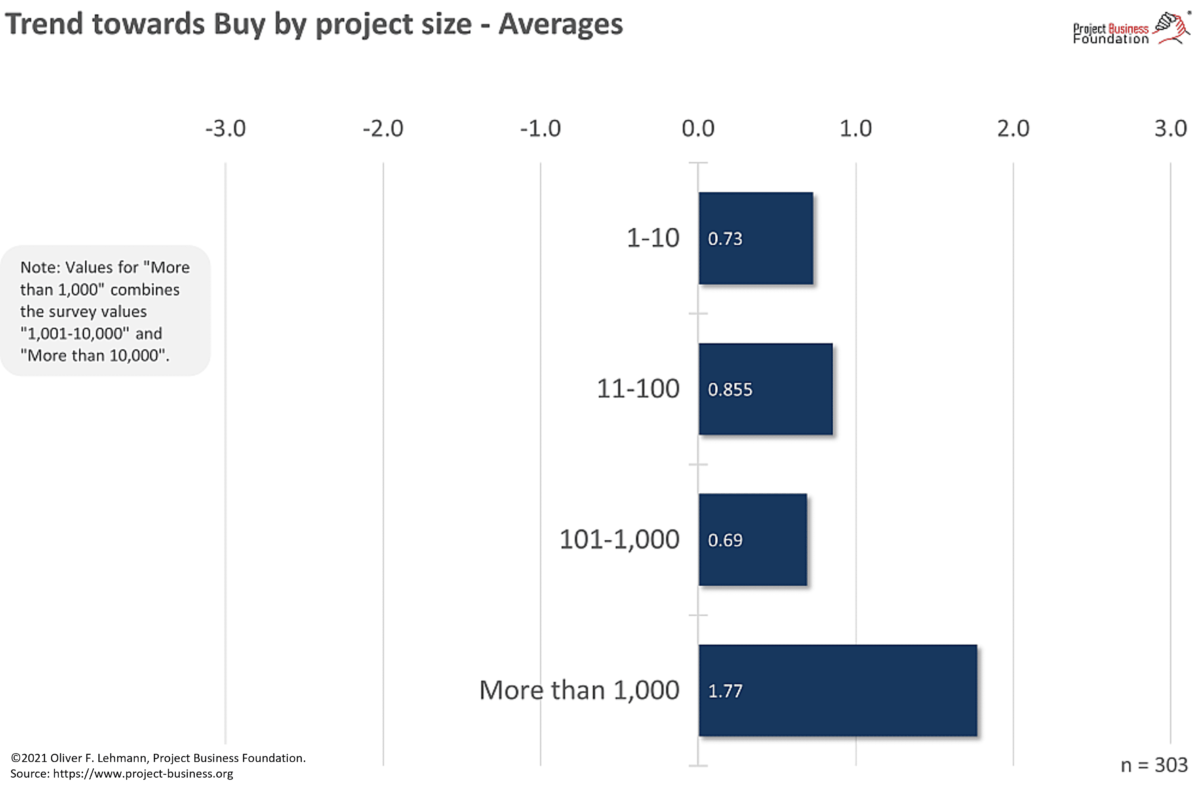

4. Project Business Today: What is the workload done by project contractors?
The reported data from the survey tell us, most projects already hand out 50% or more of the project workload.
For two of three projects, project management is already project business management, according to the survey data.
One needs to further understand that on the side of the contractors who are doing these projects, there are also project managers, managing the customer projects as temporary profit centers.
Project business is not an irrelevant fringe topic of project management. Today, it is the heart and soul of the project economy.
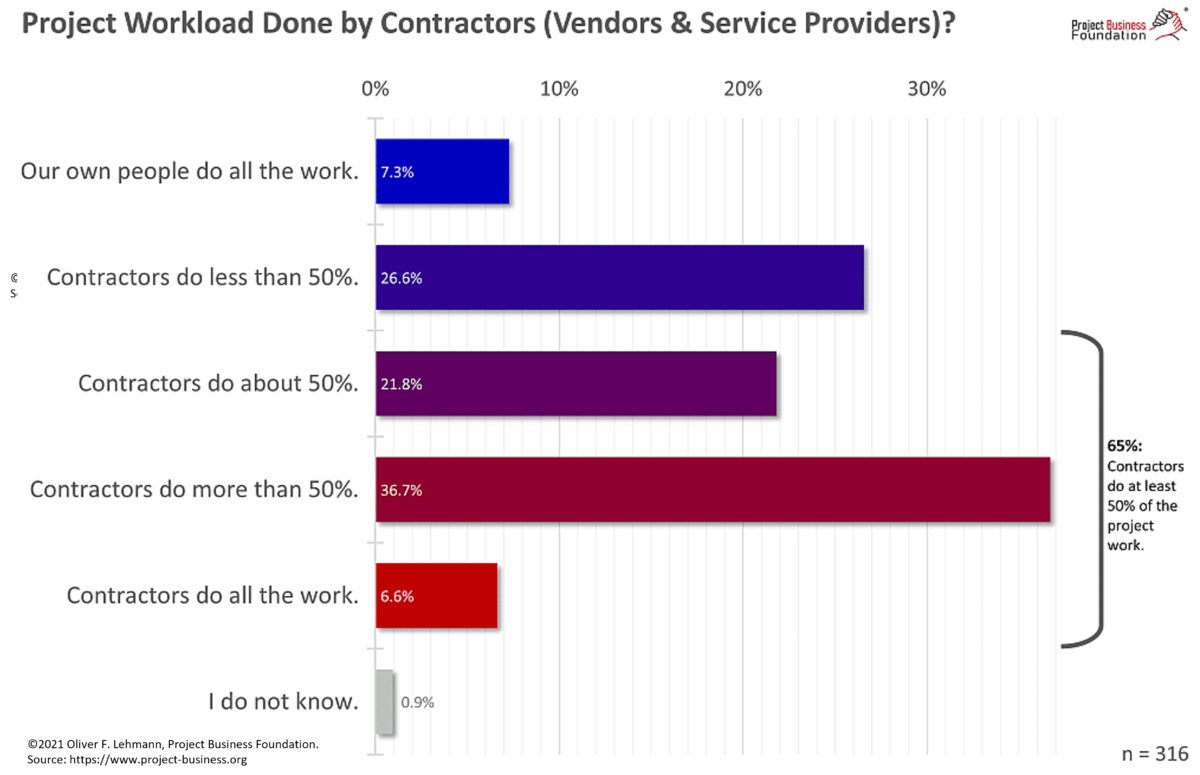

5. Comparisons 2017 – 2021
A Confirmation
The new survey confirms another poll done in December 2016/January 2017*.
_________________________
* Click here to download a detailed report of the 2017 survey from PM World Library
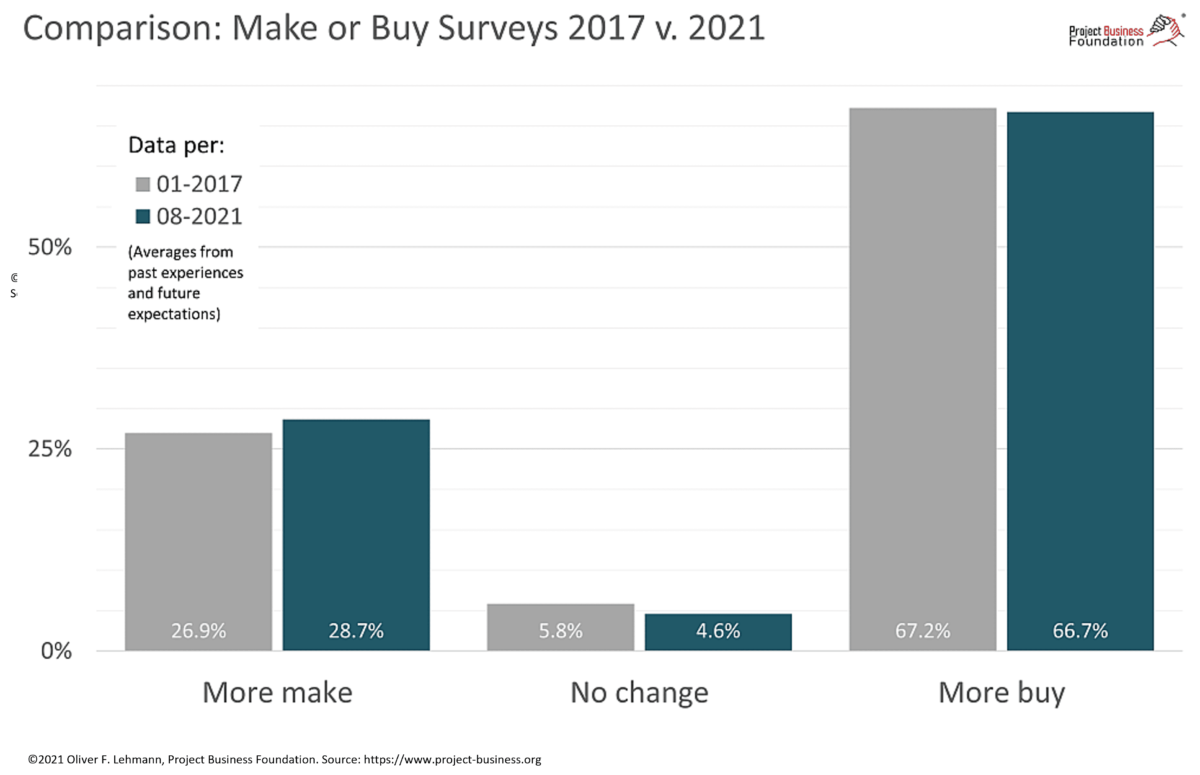
The trend is measurable.
Another comparison with numbers from the same 2017 report confirms the observable and measurable reality of the trend.
Respondents reported that the part of the work that contractors do in projects is growing. The portion of respondents reporting that at least 50% of the project work is done by contractors became significantly larger:
- 2017: 55%
- 2021: 65%
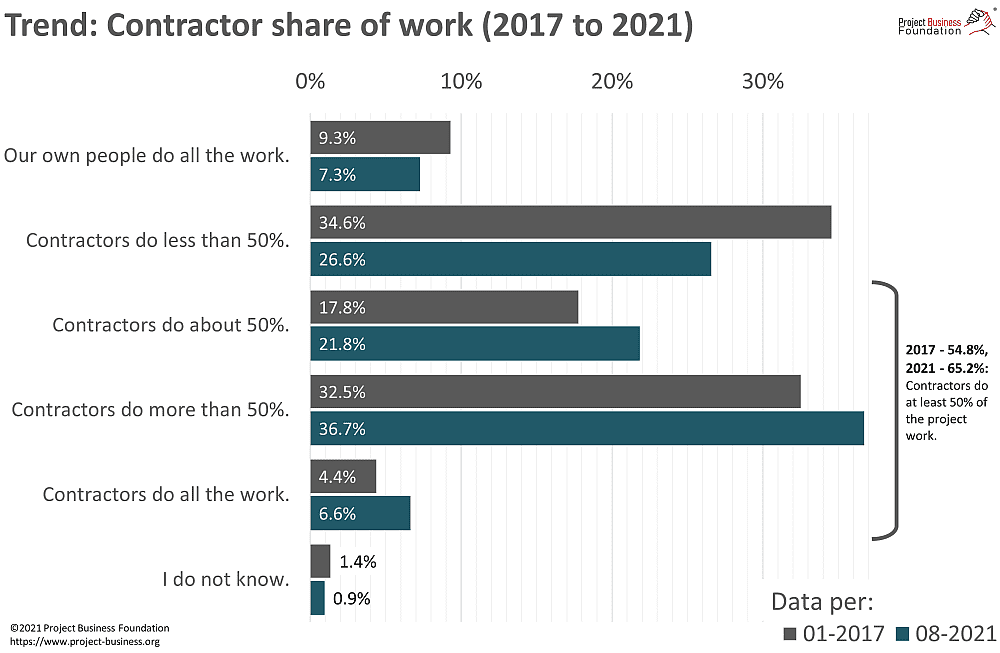

6. Conclusions
The survey brought some compelling results for the disciplines of Project Management and Project Business Management:
- Project Business is a robust market and soaring as the dominant driver of the Project Economy.
- The vast majority of traditional centers of knowledge in Project Management, such as education, literature, research, associations, and more, have sharpened their focus on internal projects.This is no longer enough. Project management fails to keep pace with today’s reality, where projects are more than just a tool to support a business—projects are the business.
- Experts in project management love passionate discussions about topics such as agile methods/mindsets vs. traditional approaches.
However, these discussions fail to include a core aspect of project management in our time: How to successfully run projects as a business on buying or selling side. - Project managers need skills on top of commonly trained Project Management: They need to understand themselves as managers of temporary commercial endeavors, competent in the management of business relationships, but also in legal and financial matters.
- Corporations must help their project managers develop their skills in managing Project Business. Project business is high-risk business, and the cost of failure is immense.
As a not-for-profit platform, the Project Business Foundation has defined its mission: Help organizations and individuals cope with the complex challenges of Project Business Management. The survey confirms that there is a profound need for such help.
To learn more about project business management and how you can use the Project Business Foundation as a center of solution competency, contact: [email protected].

7. Are Practitioners Sufficiently Prepared?
Another study made in February/March 2022 asked whether practitioners believe they are sufficiently educated for the job in Project Business Management.
Here are their responses:
https://project-business.org/research/report-education-for-pbm
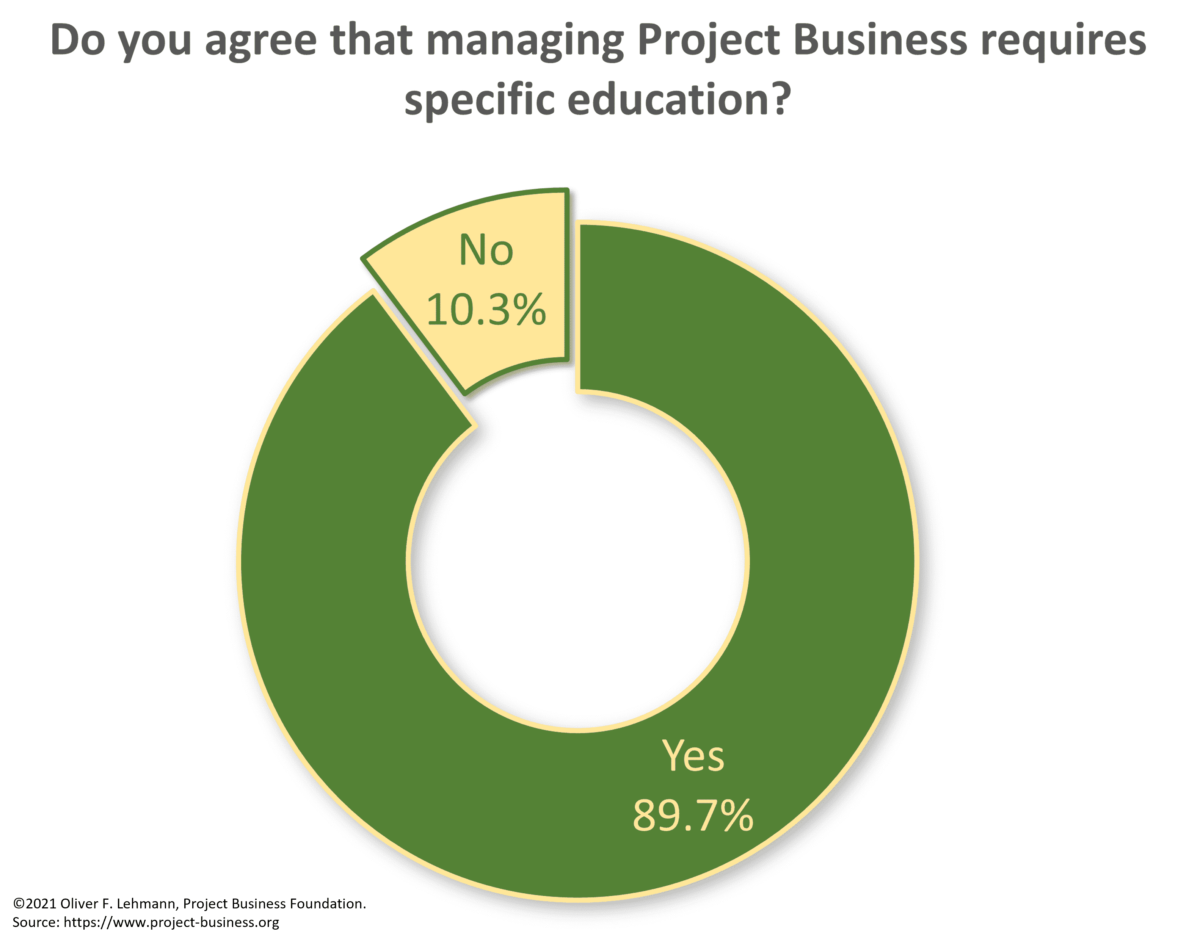

8. A Selection of Participants’ Comments
Survey participants could leave a message. Here is what they told us.
Good topic for the current situation.
Very good approaches.
In my company some hubs are created in lower income countries.
Nice topic.
Recently I have seen that there is a greater preference in buying solutions to let them be built by specialized entities in lines of business.
I think this survey is missing a few key questions – company size, industry, the buy and modify vs. buy and use as is.
It is better to insource talent and build capacity within one’s own organisation.
As the products and services become more specialist in nature and also as the suppliers of some of these products and services benefit from increased economies of scale, the make or break decision moves closer to the buy areas of the spectrum enabling us to focus more on our core business objectives.
Organizations today are re-thinking the effectiveness of buying more vs making within. There will always be physical components that must be bought but the choice to buy other external services vs making within will depend on the composition of project scope, schedule, cost, and risk analysis, and availability of skilled trades and professionals.
Make or buy depends on the situation, my organisation tends to buy components (software) and then act as the Systems Integrator between the different vendors.
Governments business in construction for health care so most of the time it will be contracted out no in house capabilities. PMs, QA, are in house the rest is outsourced.
We are in times of big change in Subsaharan Africa both in Project Management & in how business is run. I am looking forward to seeing the changes that will come.
Our sub contractors are doing all the work but we are the final decision maker.
Looking for the results and interested in what types of projects are being discussed.
When dealing with contractors deadlines and pay schedules need to be clear and precise.
Looking for the results and interested in what types of projects are being discussed.
Subcontractor are expected to be specialists, but we as project managers must work well with them to make them effective and obtaining good project results. Then we need to involve subcontractors from the very beginning of the project, even if they do not need to start their work immediately, but getting them engaged, involved and giving inputs and feedback.
Nowadays, it is a lot easier to find somebody who is an expert selling what you want make. Your organization may not have the expertise at various stages of the production of the product which may result is poorer quality if your organization insist on making the product in-house. In the market, you can select from the best of the best and achieve your goals easily than trying to setup the infrastructure for making the product in-house.
In the field that I currently work in – IT – most equipment is made in countries which provide cheap manufacturing for example China and the surrounding East Asian countries. But very often, quality suffers because of materials and / or workmanship. it’s a trade off between cheap cost vs. quality which has to be considered most of the time.
Interesting take on studying the trend on Make or Buy, looking forward to the results!
My company is a small IT firm – there are 16 people total. We are 90% make. As we grow we are contracting out more work.
My organization is leaning towards buy so that they don’t have to maintain and enhance products.
Each decision is unique based on the prevailing variables at the time of decision making.
In large Financial Services there has been a major shift from Make (pre-2008 crisis) to Buy, but now they are realising that Buying does not necessarily reduce complexity and cost as significant customisation and integration is necessary.Note: Some comments were carefully edited for grammar, capitalization, and punctuation.
Concerning questions 1 to 4, as time passes, in the initial period, to reduce business complexities, contractors are engaged. On the other hand, companies are expected to go for backward integration, for making their own raw materials. In India, many big corporates followed this trend.
Organizations generally outsource some activities to contractors so that they can focus on their core business functions.
Appendix: The Method – How We Asked People
We wanted to know: What is the trend for the projects of corporations and other organizations? More Make? More Buy?
So we asked practitioners from the field.
The survey was held globally and was open from 22 to 30 August 2021. It was closed after 326 respondents.
The survey platform was on Surveymonkey, where the original results are still accessible.
For the first two questions, respondents could use two sliders with seven steps between -3 (= strong trend towards Make) and +3 (= strong trend towards Buy).
The following three questions used a drop-down field to choose from a list. These questions could be skipped by participants
An additional field allowed participants to leave an e-mail address to inform them about the results. A free text field allowed them to add comments.
QUESTIONS 1 + 2:
- What is your recent experience with Make-or-Buy decisions?
- What is your future expectation for Make-or-Buy decisions?
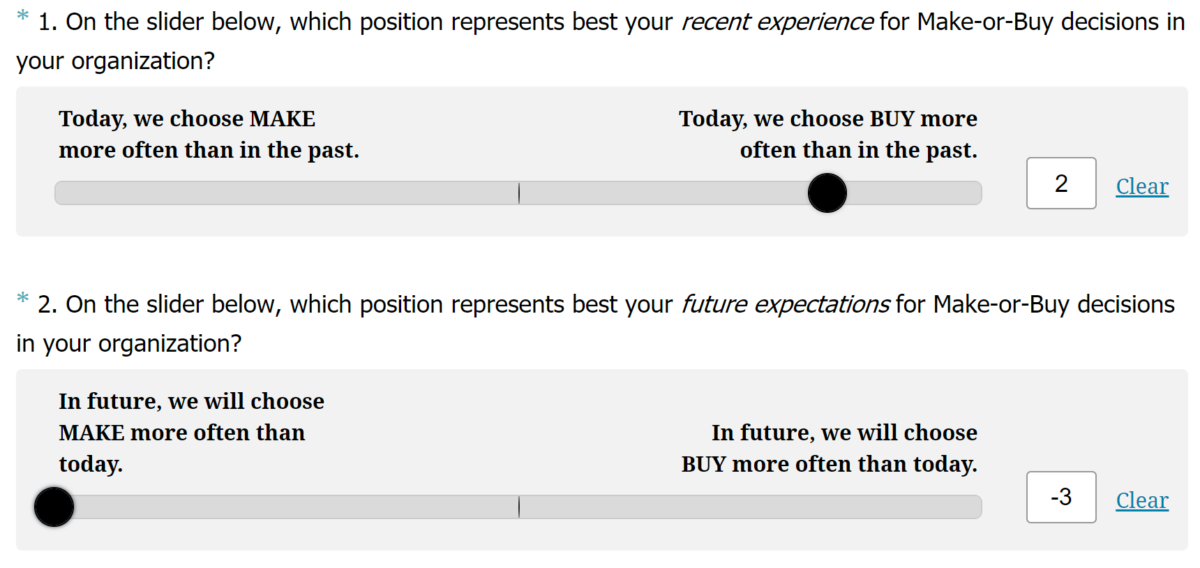
QUESTIONS 3 – 5:
Drop-down fields were used for the questions on
- Workload done by contractors
- Project size
- World region

